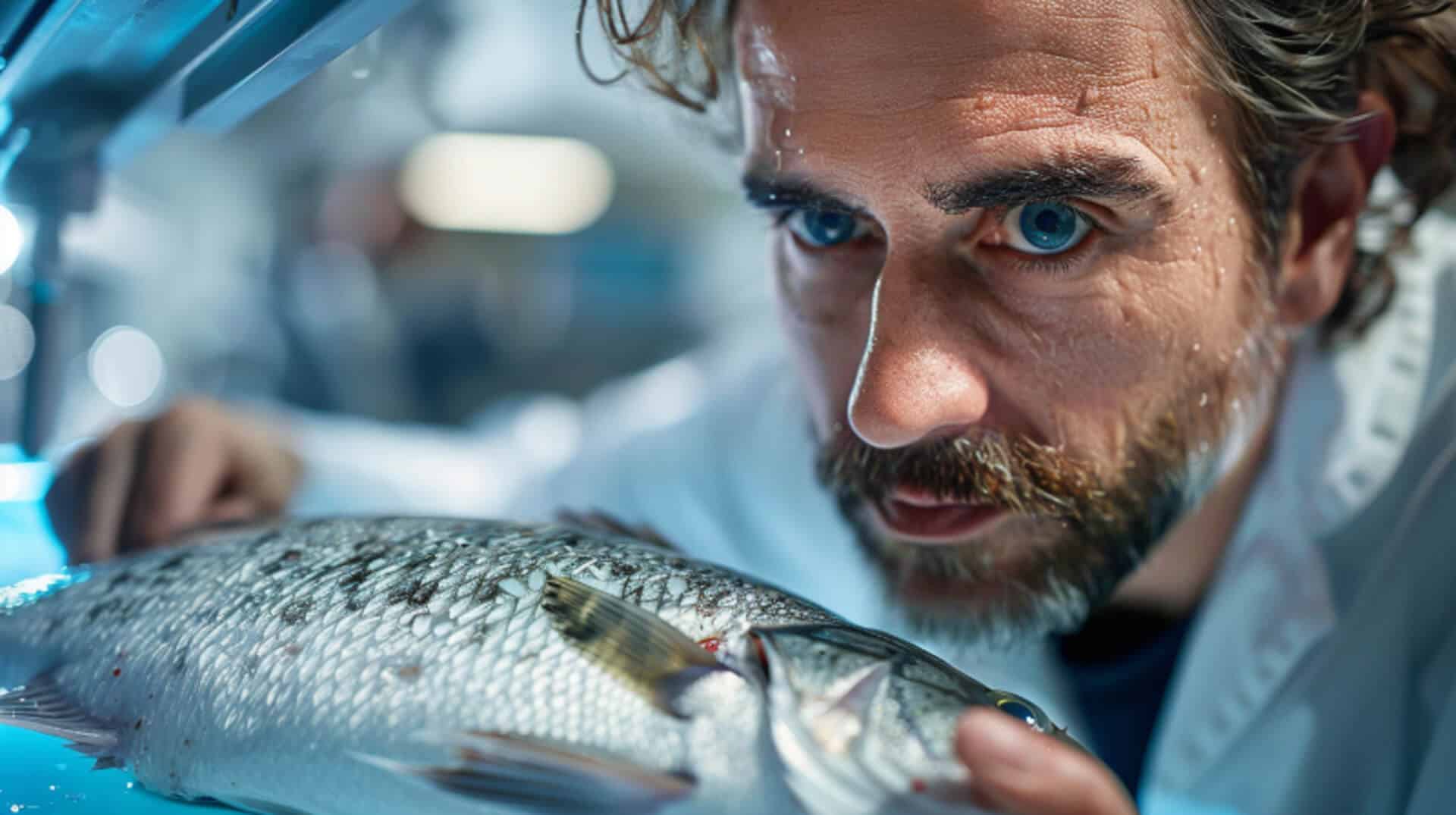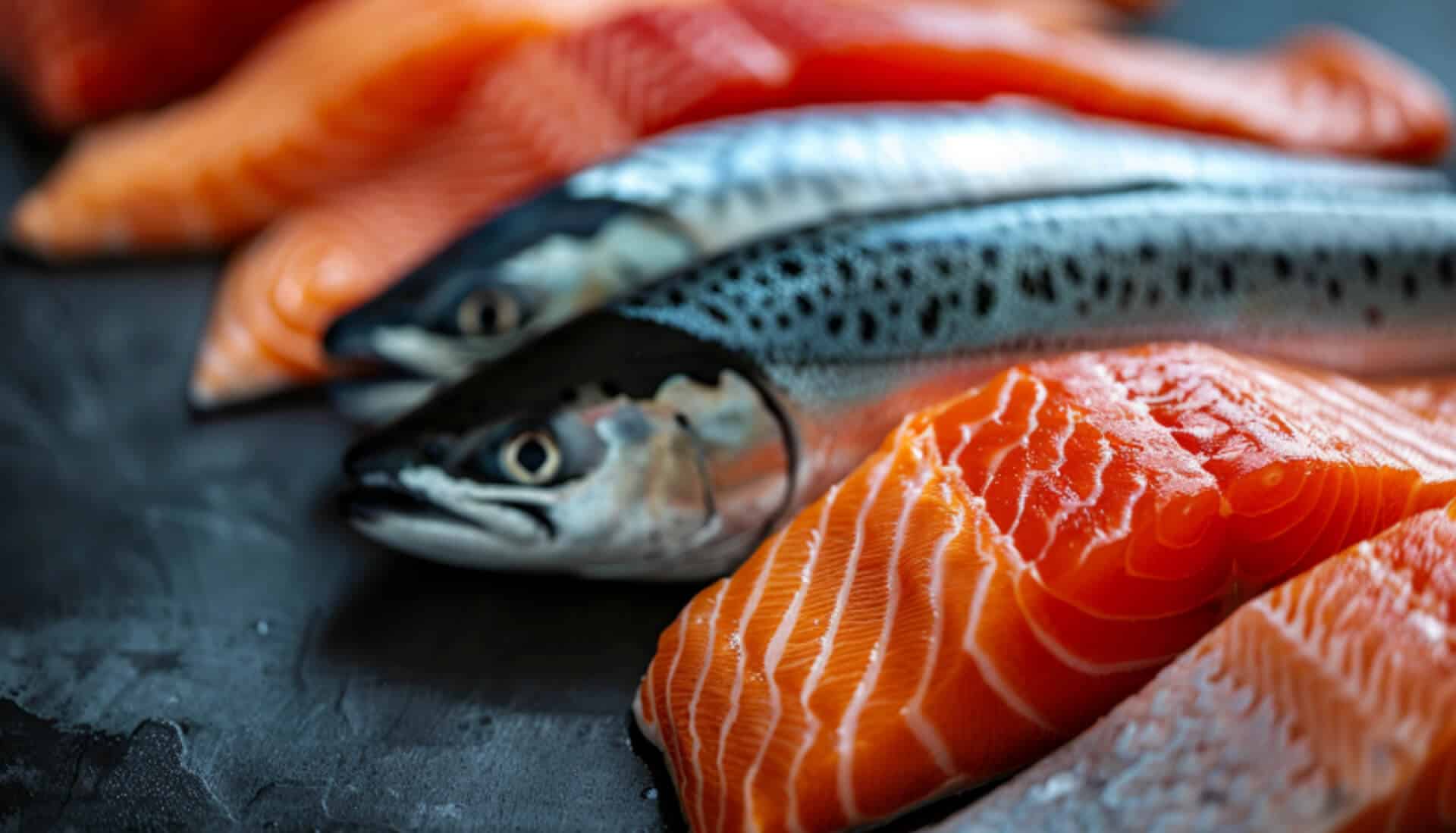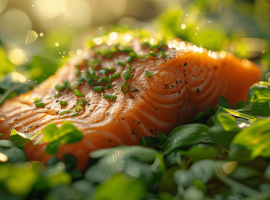Omega-3 Fatty Acids: A Visionary Nutrient
Omega-3 fatty acids are renowned for their profound impact on eye health. These essential fats, particularly docosahexaenoic acid (DHA) and eicosapentaenoic acid (EPA), are pivotal for maintaining the integrity of the retina, the light-sensitive layer of tissue at the back of the inner eye. DHA constitutes a substantial component of the retinal photoreceptors, cells that play a critical role in converting light into neural signals. EPA, on the other hand, contributes to the reduction of inflammation that can lead to degenerative eye conditions.
The Role of Omega-3 in Ocular Defence
Regular consumption of omega-3-rich fish fortifies the body’s defences against eye diseases such as macular degenerationa leading cause of vision impairment and blindness. By integrating omega-3 fatty acids into cell membranes, these nutrients enhance the fluidity and function of photoreceptors and other cells in the eye, thereby supporting optimal visual processing and health.
Harnessing Omega-3 from the Depths
The human body cannot produce omega-3 fatty acids in sufficient quantities, necessitating their acquisition through diet. Fish emerge as the quintessential source, with fatty species like salmon, mackerel, and sardines boasting high levels of these vital nutrients. When ingested, the body utilises these omega-3s to bolster ocular functions, safeguarding against dry eyes, reducing the risk of age-related macular degeneration, and promoting overall eye health.
Navigating the Sea of Choices: Top Fish for Ocular Nutrition

When considering the best fish for eye health, the focus is on those rich in omega-3 fatty acids. These essential nutrients are pivotal for maintaining vision and preventing ocular diseases.
Optimal Fish Selection for Vision Enhancement
- Salmon: Renowned for its high omega-3 content, particularly DHA, which is integral for retinal health.
- Mackerel: Another excellent source of omega-3s, supporting the overall maintenance of eye health.
- Tuna: Offers significant amounts of EPA and DHA, aiding in the reduction of inflammation associated with eye conditions.
Omega-3 Variability Among Fish Species
The omega-3 content can indeed vary among different fish species. Cold-water fish typically have higher levels of omega-3 fatty acids due to their diet and environment, which contributes to their superior benefits for eye health.
The Superiority of Cold-Water Fish
Cold-water fish are often considered superior for eye health due to their environment and diet, which lead to higher concentrations of omega-3 fatty acids. These fish accumulate omega-3s by consuming microalgae or prey fish that have consumed microalgae, the primary producers of DHA and EPA.
By incorporating these fish into your diet, you’re directly obtaining the omega-3 fatty acids that are essential for maintaining cell membranes in the eyes and supporting neurological vision processes.
Serving Up Sight: Recommended Portions and Frequency

To harness the ocular benefits of omega-3 fatty acids, health organisations typically recommend consuming two servings of fatty fish per week. Each serving should be approximately 3.5 ounces cooked, or about cup of flaked fish.
Health Organisation Guidelines on Fish Intake
- American Heart Association: Suggests two servings of fish (particularly fatty fish) per week for adults.
- Dietary Guidelines for Americans: Echoes the recommendation of at least 8 ounces of seafood per week based on a 2,000 calorie diet.
Potential Risks of Overconsumption
While fish is a key component of a healthy diet, excessive intake can lead to an accumulation of contaminants like mercury, which is detrimental to health. It’s crucial to select a variety of fish known for lower mercury levels.
Balancing Omega-3 Intake
For those seeking to balance their omega-3 intake without over-relying on fish, alternative sources include:
– Plant-based options: Flaxseeds, walnuts, and chia seeds.
– Supplements: High-quality fish oil or algae-based omega-3 supplements can also be considered, especially for individuals with dietary restrictions.
Incorporating these sources can help maintain a healthy balance of omega-3 fatty acids, contributing to optimal eye health and overall well-being.
The Mercury Dilemma: Balancing Nutrients and Toxins

Mercury exposure from fish consumption poses a risk to eye health, potentially leading to visual impairment. Understanding which fish are laden with mercury and which are not is crucial for maintaining ocular health.
Identifying Low-Mercury Fish
Fish with lower risks of mercury contamination include:
– Salmon
– Sardines
– Trout
These species are typically lower on the food chain and have shorter life spans, which contributes to their lower mercury content.
Ensuring Safe Fish Consumption
To ensure the selection of the safest fish options, consumers are advised to:
– Consult regional advisories on local fish species and water bodies.
– Opt for smaller, younger fish which generally accumulate less mercury.
– Diversify fish choices to minimise mercury exposure from a single source.
Measures for Minimising Mercury Risks
Organisations like “Frozen Fish Direct” implement stringent measures to minimise mercury risks:
– Sourcing fish from waters known for low contamination levels.
– Regularly testing fish batches for mercury and other toxins.
– Providing clear labelling and information on the source and safety of their products.
By taking these steps, “Frozen Fish Direct” ensures that the benefits of fish consumption for eye health are not overshadowed by the risks associated with mercury exposure.
Beyond Omega-3: A Spectrum of Nutrients for Vision

Fish are not only a source of omega-3 fatty acids but also a treasure trove of various nutrients that bolster eye health.
Vital Vitamins in Fish for Ocular Wellness
Fish provide an array of vitamins crucial for eye health, including:
- Vitamin D: Essential for immune regulation and inflammation control, which can affect ocular health.
- Vitamin B2 (Riboflavin): Plays a significant role in reducing oxidative stress in the eyes, potentially lowering the risk of cataracts.
Minerals in Fish Supporting Vision Maintenance
The mineral content in fish also contributes to eye health:
- Zinc: Found in high concentrations within the eyes, zinc is vital for the formation of visual pigments in the retina.
- Selenium: An antioxidant that helps protect the eyes from free radical damage.
Fish Varieties Rich in Additional Nutrients
Certain fish stand out for their rich nutrient profiles:
- Salmon: Offers a wealth of vitamin D, B vitamins, and selenium.
- Mackerel: Besides omega-3s, it is a good source of vitamin D and selenium.
- Tuna: High in B vitamins and selenium, supporting overall eye health.
Incorporating these fish into your diet can contribute to a comprehensive approach to maintaining vision and preventing eye-related conditions.
Preparing Fish for Maximum Eye Health Benefits

Proper preparation of fish is essential to maximise the retention of omega-3 fatty acids, which are vital for eye health.
Healthiest Cooking Methods to Preserve Nutrients
To retain the eye-beneficial nutrients in fish, consider the following cooking methods:
- Grilling and Baking: These methods preserve omega-3 content and provide a flavorful meal without adding unhealthy fats.
- Steaming: Keeps the fish moist and prevents the loss of omega-3s that can occur with high-heat methods.
Impact of Cooking Temperature on Omega-3 Content
The omega-3 content in fish can be affected by cooking temperature:
- Low to Medium Heat: Recommended to maintain the integrity of omega-3 fatty acids.
- Avoid High Heat: Excessive temperatures can break down these fatty acids, diminishing their nutritional value.
Preparation Methods to Avoid
To ensure the health benefits of fish are not compromised, avoid:
- Deep Frying: High temperatures and the use of unhealthy oils can degrade omega-3s and add harmful fats.
- Overcooking: Can lead to a significant reduction in beneficial omega-3 fatty acids.
“Frozen Fish Direct” and Healthy Preparation Options
“Frozen Fish Direct” offers a variety of fish that are flash-frozen to lock in nutrients, ensuring that you receive the maximum eye health benefits. They provide:
- Pre-portioned Fillets: For convenient and precise cooking.
- Cooking Guides: To assist you in preparing fish in a way that maintains its nutritional profile.
By choosing “Frozen Fish Direct” for your seafood needs, you’re ensuring that your meals are not only delicious but also optimised for your eye health.
Plant-Based Omega-3s: Alternatives for Non-Fish Eaters

For individuals who abstain from fish, there are several plant-based sources of omega-3 fatty acids that can support eye health.
Top Plant-Based Omega-3 Sources
- Flaxseeds and Flaxseed Oil: Rich in ALA, which the body can partially convert to EPA and DHA.
- Chia Seeds: Contain ALA and are also high in fibre and protein.
- Walnuts: Another good source of ALA, beneficial for maintaining cell structure in the eyes.
Ensuring Adequate Omega-3 Intake for Vegetarians and Vegans
Vegetarians and vegans can ensure they are getting enough omega-3s by:
- Incorporating a variety of ALA-rich foods into their diets.
- Considering fortified foods, such as certain brands of eggs, yoghourt, and milk alternatives.
Recommended Supplements for Omega-3
For those who do not consume fish, the following supplements are recommended:
- Algae-based Omega-3 Supplements: Offer EPA and DHA directly and are suitable for vegetarians and vegans.
- High-Quality Flaxseed Oil Capsules: Can provide a significant amount of ALA.
Comparing Plant-Based Omega-3s to Fish Sources
While plant-based omega-3s primarily provide ALA, which is less efficiently converted to EPA and DHA compared to fish sources, they still offer a valuable means to support eye health, particularly for those following plant-based diets. Regular inclusion of these sources can contribute to the overall intake of omega-3s, which are essential for retinal function and visual acuity.
The Role of Diet in Preventing Common Eye Conditions

Regular fish consumption is associated with a lower risk of age-related macular degeneration (AMD) due to the high levels of omega-3 fatty acids, particularly docosahexaenoic acid (DHA) and eicosapentaenoic acid (EPA), which are prevalent in the retinal structure.
Impact of Omega-3s on Macular Health
- DHA: Integral to the health of cell membranes in the retina, DHA may help to preserve central vision.
- EPA: Reduces inflammation that could contribute to the progression of AMD.
Fish and Dry Eye Syndrome
Consuming fish rich in omega-3 fatty acids may alleviate symptoms of dry eye syndrome by improving meibomian gland function, which secretes oils essential for a healthy tear film.
Omega-3s in Glaucoma and Cataract Prevention
Omega-3 fatty acids may lower intraocular pressure, a key risk factor for glaucoma, and have been linked to a reduced risk of cataracts through their antioxidative and anti-inflammatory properties.
Balanced Diet for Eye Health
A diet that includes a variety of fish can contribute to overall eye health by providing:
- Essential Fatty Acids: For cellular health and visual development.
- Vitamins and Minerals: Such as Vitamin D and B2, which support eye function and protect against disease.
Incorporating fish into a balanced diet, alongside other nutrient-rich foods, supports ocular health and may prevent common eye conditions.
Children’s Vision and Omega-3: Laying the Foundation

Omega-3 fatty acids, particularly docosahexaenoic acid (DHA), are essential for the development of a child’s vision and brain. DHA constitutes a significant portion of the retina and brain tissue, making it crucial for visual acuity and cognitive functions.
The Role of Omega-3 in Visual and Cognitive Development
- DHA: A major structural component of the retina, essential for the development of vision in infants and children.
- Brain Development: Omega-3 fatty acids, including DHA and EPA, are vital for neurodevelopment and may improve cognitive function and reduce symptoms of ADHD.
Recommendations for Omega-3 Intake in Children
Health authorities suggest the following omega-3 intake for children:
- Infants: Breast milk is the preferred source of DHA; formulas fortified with DHA are recommended for non-breastfed infants.
- Children: Incorporate fish into meals 1-2 times per week, with attention to low-mercury options like salmon and trout.
“Frozen Fish Direct” and Nutritional Support for Children
“Frozen Fish Direct” caters to the nutritional needs of children by:
- Offering a selection of low-mercury, omega-3-rich fish, suitable for family meals.
- Providing portion-controlled options that make it easier for parents to serve appropriate amounts to children.
- Ensuring that all seafood is frozen quickly after catch, preserving the integrity of nutrients essential for eye health.
The Environmental Angle: Sustainable Fishing and Eye Health

Environmental factors play a significant role in the quality of fish, impacting both the ecosystem and the nutritional value of the seafood consumed. Sustainable fishing practices are essential to ensure the long-term viability of fish populations and the health benefits they offer.
Sustainable Practices for Quality Seafood
- Habitat Protection: Sustainable fishing methods avoid damaging the seabed, preserving the natural habitat essential for fish to thrive.
- Selective Gear: Using fishing gear designed to minimise bycatch helps maintain biodiversity and the balance of marine ecosystems.
Making Environmentally Responsible Seafood Choices
Consumers can contribute to environmental stewardship by:
- Checking Certifications: Look for seafood certified by reputable organisations like the Marine Stewardship Council (MSC).
- Supporting Local Fisheries: Choose locally sourced fish to reduce carbon footprint and support community-based fishing practices.
“Frozen Fish Direct” Commitment to Sustainability
“Frozen Fish Direct” supports sustainable fishing through:
- Sourcing Transparency: Providing detailed information about the origin and method of catch for all their products.
- Eco-Friendly Packaging: Utilising materials that are recyclable or biodegradable to minimise environmental impact.
By prioritising sustainability, “Frozen Fish Direct” ensures that the fish provided not only contributes to your eye health but also to the health of the planet’s oceans.
Eye Health Myths and Facts: Debunking Common Misconceptions

In the realm of eye health, misconceptions about fish consumption and its benefits are prevalent. It’s essential to separate fact from fiction to make informed dietary choices.
Clarifying Myths About Fish and Eye Health
Common myths include the belief that only expensive fish provide eye health benefits or that all seafood poses a high risk of mercury contamination. In reality, a variety of fish, including affordable options like sardines and trout, offer omega-3 fatty acids beneficial for eye health, and many have low mercury levels.
Fish Oil Supplements vs. Whole Fish: The Research
Recent studies suggest that while fish oil supplements can be beneficial, consuming whole fish provides a broader range of nutrients that contribute to eye health, such as protein, vitamins, and minerals, which are not present in supplements.
Discerning Factual Information
To discern factual information:
– Look for research from reputable sources such as peer-reviewed journals.
– Consult with healthcare professionals for personalised advice.
“Frozen Fish Direct” Resources for Eye Health Education
“Frozen Fish Direct” offers resources to educate consumers on eye health, including:
– Detailed nutritional profiles of their seafood products.
– Information on the best fish choices for eye health based on the latest research.
– Guidance on how to safely incorporate fish into your diet for optimal ocular benefits.
Integrating Fish into Your Diet for Vision Vitality

Incorporating fish into your diet can significantly contribute to eye health, thanks to the essential omega-3 fatty acids, vitamins, and minerals found in seafood.
Tailoring Fish Consumption to Personal Health Needs
To tailor fish consumption to your health needs, consider the following:
- Assess Dietary Restrictions: If you have dietary restrictions or allergies, seek alternative omega-3 sources such as flaxseeds or supplements.
- Monitor Health Conditions: For conditions like high blood pressure, opt for fish lower in sodium and avoid added salts during preparation.
Simple Steps to Improve Eye Health Through Diet
You can start improving your eye health through diet by:
- Increasing Omega-3 Intake: Aim for at least two servings of omega-3-rich fish per week.
- Diversifying Your Diet: Include a variety of fish to benefit from different nutrient profiles.
- Being Mindful of Mercury: Choose fish known for lower mercury content, such as salmon and sardines.
“Frozen Fish Direct” and Informed Choices for Eye Health
“Frozen Fish Direct” assists customers in making informed choices by:
- Providing a wide selection of fresh, nutrient-rich fish options.
- Offering detailed information on the omega-3 content and potential contaminants of each fish type.
- Ensuring that all seafood is responsibly sourced and meets high-quality standards for safety and nutrition.
By following these guidelines, you can confidently integrate fish into your diet for the betterment of your eye health.









